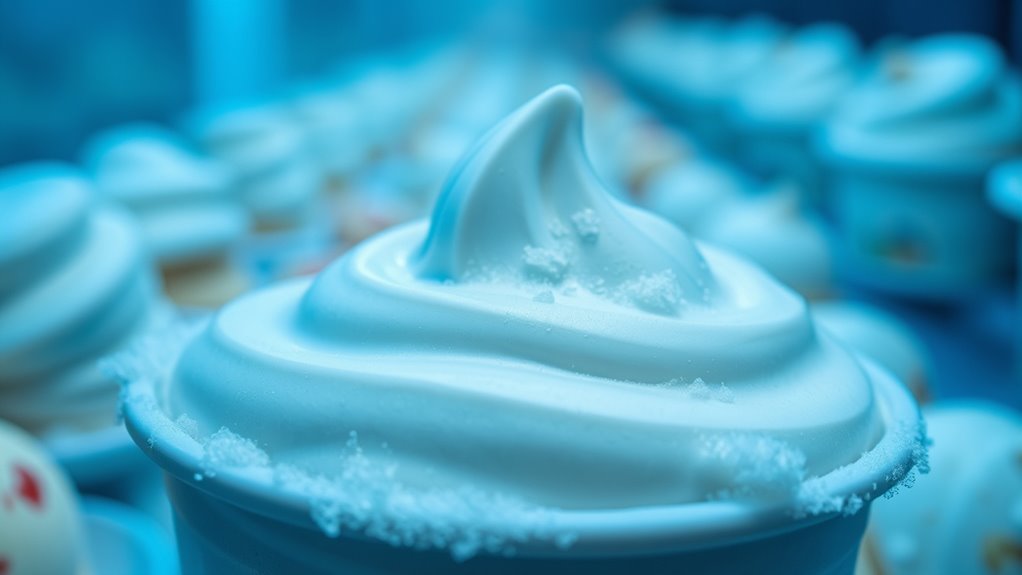You can’t keep ice cream forever, but proper storage can make it last longer. Maintaining a consistent freezer temperature of 0°F (-18°C) prevents large ice crystal formation and freezer burn, keeping its texture and flavor intact. Sealing it tightly and minimizing air exposure also help prevent spoilage. While it won’t last forever, following best storage practices can extend its quality. Keep going to discover detailed tips on maximizing your ice cream’s shelf life.
Key Takeaways
- Ice cream cannot last forever; its quality diminishes over time due to freezer burn and moisture loss.
- Proper storage at 0°F (-18°C) or lower and minimal air exposure help extend shelf life.
- Freezer burn affects texture and flavor but does not make ice cream unsafe to eat.
- Fluctuations in storage temperature accelerate spoilage and deterioration of quality.
- Regularly monitoring freezer conditions and maintaining a full, well-sealed container prolongs ice cream’s freshness.

Have you ever wondered how long your ice cream stays good in the freezer? The answer isn’t as simple as you might think. Several factors influence its shelf life, with freezer burn and storage temperature being the most significant. Freezer burn happens when ice crystals form on the surface of the ice cream due to moisture loss, leading to dry, chalky patches and a stale flavor. It doesn’t make the ice cream unsafe to eat, but it does compromise taste and texture. To prevent freezer burn, you need to pay close attention to your storage practices and maintain a consistent freezer temperature. Proper storage practices, such as minimizing air exposure and maintaining the correct temperature, can greatly extend the quality of your ice cream.
Your freezer temperature plays a vital role in preserving ice cream’s quality. Ideally, it should stay at 0°F (-18°C) or lower. When your freezer fluctuates above this temperature, ice cream becomes more vulnerable to spoilage and freezer burn. Consistent temperature control helps prevent the formation of large ice crystals that ruin the smooth, creamy texture you want. If your freezer isn’t set properly, or if you frequently open the door, the temperature can rise temporarily, causing the ice cream to partially melt and refreeze, which accelerates freezer burn. Keeping your freezer full or adding a block of ice can help stabilize the temperature, ensuring your ice cream remains in top condition longer. Additionally, understanding the shelf life of ice cream can help you plan your consumption and avoid waste.
Frequently Asked Questions
Does Homemade Ice Cream Last Longer Than Store-Bought?
You might wonder if homemade ice cream lasts longer than store-bought. Generally, store-bought ice cream has preservatives and stabilizers that extend its shelf life. Homemade ice cream, made with fresh ingredients and fewer preservatives, doesn’t last as long. Proper storage techniques, like keeping it airtight and at consistent freezing temperatures, help prolong its freshness. So, store-bought usually lasts longer, but careful storage can improve homemade ice cream’s longevity.
How Does Temperature Fluctuation Affect Ice Cream’s Shelf Life?
Temperature fluctuations can seriously sabotage your ice cream’s shelf life, causing chaos in its consistency and quality. When temperatures wobble, your ice cream faces the risk of freezer burn and deterioration. Maintaining temperature stability is key to keeping it creamy and cold, preventing unwanted ice crystals and spoilage. So, avoid frequent opening and closing of the freezer, and keep your ice cream at a steady, freezing point for maximum freshness and flavor.
Can Ice Cream Become Toxic if Stored Too Long?
You might wonder if ice cream can become toxic over time. While it’s unlikely to cause food poisoning if stored properly, it can develop mold growth or rancidity, which can be harmful if ingested. Extended storage increases risks, especially if temperature fluctuations occur. To stay safe, always check for unusual odors, textures, or colors before eating, and discard ice cream that shows signs of spoilage.
Do Different Ice Cream Flavors Have Different Shelf Lives?
Different ice cream flavors can have varying shelf lives because of flavor stability and ingredient variations. You might notice that fruit-based or dairy-heavy flavors spoil faster than more stable options like vanilla or chocolate. These ingredient differences affect how long the ice cream maintains its quality. So, always check for changes in texture, smell, or taste, as these can signal that your favorite flavor isn’t at its best anymore.
Is It Safe to Eat Ice Cream After Its Expiration Date?
Did you know that consuming expired ice cream can sometimes lead to foodborne illnesses? While many think it’s safe as long as it looks and smells okay, microbial growth may still occur past the expiration date. Eating ice cream after its date isn’t always safe, especially if it shows signs of freezer burn or ice crystals. Always check for unusual texture or smell before indulging to avoid potential health risks.
Conclusion
So, while ice cream might seem like a timeless treat, its shelf life is like a delicate dance on thin ice—once it melts or gets freezer burn, its quality fades away. To keep your favorite flavors at their best, store them properly and watch for signs of spoilage. Remember, ice cream’s lifespan is a fleeting whisper in the freezer, so enjoy it before it slips away like a dream on a warm summer day.










